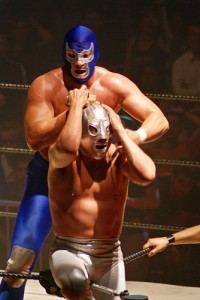- 602-888-9113 Main Office
- 1-888-502-2761 Toll Free US
- (622)226-0007 San Carlos
 Professional wrestling is not just an American sport. The people of Mexico also enjoy wrestling as a professional sport and entertainment. Mexico’s “lucha libre” is rich in history, providing entertainment for crowds for more than 100 years. Anyone seeking to experience lucha libre in person should plan a Mexican vacation to one of the many hotels in the country. Immersing yourself in the Mexican culture can be a fascinating excursion.
Professional wrestling is not just an American sport. The people of Mexico also enjoy wrestling as a professional sport and entertainment. Mexico’s “lucha libre” is rich in history, providing entertainment for crowds for more than 100 years. Anyone seeking to experience lucha libre in person should plan a Mexican vacation to one of the many hotels in the country. Immersing yourself in the Mexican culture can be a fascinating excursion.
How it Began
Lucha libre means “free fight,” which is an apt description of the sport. Wrestlers engage in hand-to-hand combat without using weapons or protection. Lucha libre made its debut in Mexico during the Mexican revolution that occurred during the early 1900s. The residents of Mexico needed a diversion to distract them from the political unrest that was enveloping their country. Two businessmen from Italy, Giovanni Reselevich and Antonio Fournier, began organizing and promoting matches between fighters. Salvador Lutteroth Gonzalez discovered a form of the sport being performed in El Paso, Texas, in 1929. He went to Mexico City and re-created the sport with a partner in 1933. The sport became popular, and a large arena is the current venue for fighting matches in Mexico City.
 Masks
Masks
Wrestlers engaging in fights wear masks. The use of masks has been a constant feature of lucha libre since its inception. The masks are a sacred part of the fighters’ identities. Initially, the masks were simple, with specific colors that identified each wrestler. Over time, masks have evolved to become more colorful and intricate. Fighters’ masks often feature designs with animals, heroes, and gods. In the beginning of wrestlers’ careers, they fight wearing masks. At some point, many wrestlers will become unmasked, and they will fight from that point on without wearing masks. Some fighters wait until a final tour before retirement to unmask themselves.
Similarities and Differences to American Pro Wrestling
Mexican and American professional wrestling has both similarities and differences. Wrestling in both countries involves battles to win championship titles. Lucha libre fighters are separated into highly specific weight classes, as opposed to a slightly less specific weight class division in America. Both Mexican and American pro wrestlers have popular personas, usually followed energetically by adoring fans. Mexican wrestlers may have some anonymity due to their masks, whereas most American wrestlers compete without masks that hide their identity. Lucha libre fighters are usually smaller in stature than American wrestlers. Lucha libre fighting moves orchestrated in the ring tend to be more airborne, while American wrestlers focus their moves on delivering more power to their opponents. With their smaller body size, Mexican wrestlers usually show a higher level of acrobatic skill when compared to American wrestlers.
Famous Wrestlers
A number of wrestlers have fought their way into lucha libre history in Mexico. These luchadores may fight individually, or they could engage in tag-team matches. Luchadores split into two different categories: those who fight by the rules and those who do not. The “rudos” are the bad guys who specialize in breaking rules whenever they can. The “tecnicos” are the good guys who follow the rules, yet deliver complex moves to try to subdue their opponents. The luchadore “Místico” incited excitement among his Mexican followers as he fought his way to the top in 2006. Rey Mysterio Jr. has been a popular fighter since the 1990s, and he also earned fame in America by wrestling with the WWE. Gory Guerrero was a legendary fighter who did not wear a mask. Karloff Lagarde was a legendary rudo with an impressive history of successful matches and title reigns. Although advancing in age, Mil Mascaras remains active in the ring. During his prime, he impressed audiences with aerial maneuvers in the ring. In fact, he was the first fighter to use common moves such as the “tope suicida” and the “plancha.”